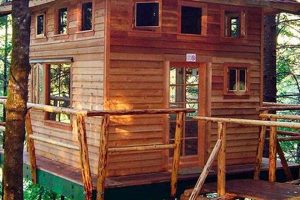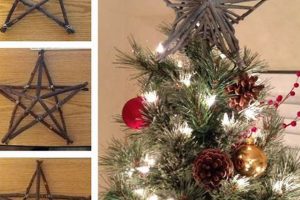The creation of festive evergreen displays for exterior spaces involves a multifaceted approach encompassing design, material selection, and construction techniques. These personalized decorations serve as prominent seasonal markers, transforming residential and commercial exteriors. For example, the arrangement might involve repurposing natural elements like branches and pinecones or fabricating structures from materials such as wood or metal, subsequently adorned with lights and ornamentation.
Employing handcrafted seasonal displays outdoors offers several advantages, including enhanced aesthetic appeal and fostering a sense of holiday spirit within the community. Historically, evergreen decorations have symbolized enduring life and hope during the winter months, a tradition that continues to resonate. Furthermore, the construction and display of these items can promote resourcefulness and environmental consciousness through the use of recycled or locally sourced materials.
The following sections will detail various construction methods, material options, and design considerations for establishing unique and visually appealing festive evergreen displays tailored for exterior environments. These considerations will also cover aspects of safety and sustainability.
Essential Considerations for Exterior Seasonal Evergreen Displays
Constructing festive evergreen displays intended for outdoor placement requires careful attention to detail and adherence to specific guidelines. Prioritizing safety, durability, and aesthetic harmony ensures a successful and visually appealing result.
Tip 1: Secure Foundation: Establishing a stable base is paramount for preventing toppling due to wind or inclement weather. Employ weighted stands or ground anchors to ensure the structure remains firmly in place.
Tip 2: Weather-Resistant Materials: Select materials inherently resistant to moisture, UV exposure, and temperature fluctuations. Treated lumber, galvanized steel, and outdoor-rated lighting fixtures are recommended.
Tip 3: Proper Lighting Selection: Utilize lighting specifically designed for exterior use. Consider LED options for energy efficiency and prolonged lifespan. Ensure all electrical connections are weatherproofed and properly grounded.
Tip 4: Balanced Ornamentation: Distribute decorations evenly to maintain visual equilibrium and prevent structural imbalances. Avoid overloading any single branch or section.
Tip 5: Consider Local Climate: Adapt the design and materials to suit the prevailing weather conditions of the region. In areas with heavy snowfall, opt for a streamlined structure that minimizes snow accumulation.
Tip 6: Wildlife Awareness: When incorporating natural elements, exercise caution to avoid attracting unwanted wildlife. Refrain from using food-based decorations that may entice animals.
Tip 7: Safe Electrical Practices: Adhere strictly to all electrical safety codes and guidelines. Use ground fault circuit interrupters (GFCIs) to prevent electrical shock and regularly inspect wiring for damage.
The incorporation of these recommendations will contribute to the creation of a durable, visually appealing, and safe outdoor festive evergreen display. Diligence in these areas ensures longevity and reduces the risk of accidents or damage.
The subsequent sections will elaborate on specific design styles and aesthetic considerations to further enhance the impact of these outdoor seasonal displays.
1. Structural Integrity
Structural integrity represents a fundamental consideration in the successful execution of exterior festive evergreen displays. The ability of the structure to withstand environmental stressors, such as wind, snow, and ice, directly impacts its longevity and safety. A lack of adequate structural design can result in collapse, potentially causing damage to property or injury to individuals. For example, a large evergreen display constructed with insufficient bracing may succumb to strong winds, leading to its disintegration and scattering of debris.
The selection of appropriate materials and construction techniques plays a pivotal role in achieving structural integrity. Heavy-duty frameworks constructed from treated lumber or metal provide a more robust foundation than lighter, less durable alternatives. Secure anchoring to the ground or a stable base is essential to prevent overturning. Furthermore, the distribution of weight and the overall design should minimize stress points and ensure even load bearing. Proper assembly techniques, such as the use of sturdy fasteners and reinforced joints, contribute significantly to the structure’s overall stability.
In conclusion, prioritizing structural integrity is non-negotiable when undertaking exterior festive evergreen construction. Diligence in design, material selection, and construction practices mitigates the risk of failure and ensures the safe and prolonged enjoyment of the display. Neglecting this aspect can result in costly repairs, potential hazards, and a diminished aesthetic outcome, underscoring its critical importance.
2. Weather Resistance
Weather resistance is a critical design parameter for exterior festive evergreen displays, directly influencing their longevity and aesthetic appeal. Exposure to precipitation, temperature fluctuations, and solar radiation necessitates the selection of materials and construction techniques capable of withstanding these environmental stressors.
- Material Selection and Degradation
The susceptibility of constituent materials to degradation under various weather conditions is a primary consideration. Untreated wood, for instance, is prone to rot and decay when exposed to moisture, while certain plastics may become brittle and crack under prolonged exposure to ultraviolet (UV) radiation. The selection of weather-resistant materials, such as treated lumber, PVC, or powder-coated metal, mitigates the risk of premature deterioration and extends the lifespan of the display.
- Protective Coatings and Sealants
The application of protective coatings and sealants provides an additional layer of defense against the elements. Paints, varnishes, and waterproof sealants can shield vulnerable materials from moisture penetration, UV damage, and temperature-induced expansion and contraction. The selection of appropriate coatings should be based on the specific material being protected and the prevailing weather conditions of the region.
- Fastener Durability and Corrosion Prevention
The durability of fasteners, such as screws, nails, and bolts, is crucial for maintaining the structural integrity of the display. Corrosion-prone fasteners can weaken over time, leading to structural instability and potential collapse. The use of corrosion-resistant fasteners, such as stainless steel or galvanized hardware, is recommended to ensure long-term durability.
- Drainage and Water Management
Effective drainage and water management are essential for preventing water accumulation and subsequent damage. Designs should incorporate drainage holes or channels to allow water to escape freely. Elevated platforms or footings can also help to prevent direct contact with the ground, minimizing moisture exposure and preventing rot.
The aforementioned considerations highlight the importance of weather resistance in the context of exterior festive evergreen displays. Neglecting these factors can result in premature degradation, structural failure, and a diminished aesthetic outcome, ultimately undermining the investment in the display. A proactive approach to weather resistance, through careful material selection, protective coatings, and effective drainage, ensures a durable and visually appealing result.
3. Illumination Strategies
Illumination strategies are integral to the successful execution of exterior festive evergreen displays, significantly impacting their visual appeal and safety. The integration of light transforms the evergreen arrangement from a daytime decoration into a prominent nighttime feature, enhancing its visibility and festive character. Improper illumination, conversely, can detract from the display’s aesthetic or even pose safety hazards.
Effective lighting strategies consider several factors, including the type of lighting used (LED, incandescent, etc.), the color scheme, the distribution of light, and the overall power consumption. LED lighting is increasingly favored for its energy efficiency, long lifespan, and diverse color options. Careful distribution of light ensures that all areas of the display are adequately illuminated, preventing dark spots and creating a balanced visual effect. Examples include wrapping individual branches with mini-lights for a traditional look, using spotlights to highlight specific ornaments or features, and employing projected lighting to create dynamic patterns on the surrounding surfaces. The choice of lighting should also align with local regulations regarding light pollution and energy conservation. Moreover, all electrical components must be rated for outdoor use and installed according to safety codes to prevent electrical hazards. For instance, the strategic placement of spotlights can accent the height of a crafted evergreen structure, while string lights might define its perimeter. These considerations influence not only visual appeal, but also the overall safety and functionality of the display.
In summary, illumination strategies are not merely an addendum but a critical component of exterior festive evergreen design. The proper implementation of these strategies ensures a visually appealing, safe, and energy-efficient display. Challenges arise in balancing aesthetic goals with practical considerations like energy consumption and safety regulations. The understanding and application of effective illumination strategies are vital for maximizing the impact and enjoyment of these outdoor decorations.
4. Material Sourcing
Material sourcing, in the context of exterior festive evergreen arrangements, is a primary determinant of both the aesthetic outcome and the long-term durability of the creation. The choice of materials directly influences the structure’s resistance to environmental factors, its visual impact, and its sustainability footprint. Utilizing substandard materials can lead to premature degradation, posing safety risks and diminishing the display’s overall appeal. Conversely, careful material selection ensures longevity, reduces maintenance requirements, and enhances the visual effect. For example, the selection of pressure-treated lumber for the frame significantly extends its lifespan compared to untreated alternatives. Similarly, opting for outdoor-rated lighting fixtures prevents electrical hazards associated with moisture exposure.
The practical significance of understanding material sourcing is multifaceted. Firstly, it empowers creators to make informed decisions regarding the cost-effectiveness of various options. While higher-quality materials may entail a greater initial investment, their extended lifespan and reduced maintenance requirements often result in lower overall costs. Secondly, informed material sourcing promotes sustainable practices. The use of recycled materials, locally sourced elements, and sustainably harvested wood reduces the environmental impact of the display. Thirdly, understanding material properties allows for innovative design solutions. For instance, the utilization of flexible LED strips enables the creation of intricate lighting patterns not achievable with traditional bulbs. Finally, adherence to safety standards is paramount, and responsible sourcing ensures that materials meet necessary regulations and are free from hazardous substances.
In conclusion, material sourcing is a cornerstone of successful exterior festive evergreen creation. The selection process should prioritize durability, aesthetics, sustainability, and safety. Neglecting this critical aspect compromises the long-term value and impact of the display, potentially leading to structural failures, environmental concerns, and safety hazards. A comprehensive understanding of material properties and sourcing practices is therefore essential for realizing visually compelling and enduring outdoor arrangements.
5. Design Aesthetics
Design aesthetics are intrinsic to the successful implementation of external festive evergreen displays. The visual appeal of such arrangements directly correlates with adherence to established design principles, including balance, proportion, color harmony, and focal point establishment. Failure to consider these principles can result in displays that appear disjointed, unbalanced, or visually unappealing. For instance, an outdoor evergreen display overwhelmingly dominated by a single color may lack visual interest, while one that is improperly proportioned may appear top-heavy or unstable. The incorporation of effective design aesthetics elevates the arrangement from a mere collection of materials to a cohesive and visually engaging artwork.
The practical significance of design aesthetics is further emphasized by their influence on the surrounding environment. An aesthetically pleasing outdoor display enhances the visual appeal of the property and contributes to a positive neighborhood ambiance. Conversely, a poorly designed display can detract from the overall aesthetic and potentially devalue the property. Examples include the careful selection of ornament colors to complement the exterior of the house, the strategic placement of lights to highlight architectural features, and the integration of natural elements to blend with the surrounding landscape. The application of design principles such as the golden ratio can further enhance the visual harmony of the display.
In summary, design aesthetics represent a crucial component of successful external festive evergreen creation. A thorough understanding and application of design principles ensures that the display achieves its intended visual impact, enhances the surrounding environment, and reflects a sense of artistry and attention to detail. Challenges arise in balancing individual creative expression with established design guidelines, requiring a nuanced approach that integrates personal vision with objective principles. Ultimately, the skillful application of design aesthetics transforms a simple decoration into a visually compelling and memorable seasonal statement.
6. Safety Protocols
The creation of festive evergreen displays for exterior use necessitates a stringent adherence to established safety protocols. The confluence of electricity, potentially unstable structures, and environmental factors presents inherent risks that demand proactive mitigation. The absence of comprehensive safety measures can precipitate hazardous situations, including electrical shock, structural collapse, and fire. Therefore, integrating safety protocols is not merely an ancillary consideration but an indispensable component of successful and responsible outdoor festive evergreen construction. For instance, the failure to employ Ground Fault Circuit Interrupters (GFCIs) in outdoor electrical circuits increases the risk of electrical shock in wet conditions. Similarly, neglecting to properly secure a tall evergreen structure against wind gusts can result in its overturning, posing a threat to people and property. Real-world examples of such incidents underscore the critical significance of prioritizing safety in all phases of design, construction, and maintenance.
Practical application of safety protocols manifests in several key areas. Firstly, all electrical connections must be weatherproofed and comply with local electrical codes. Outdoor-rated extension cords and light strings are essential, and regular inspection for damage is imperative. Secondly, structural stability must be ensured through the use of robust anchoring systems and appropriate weight distribution. Tall displays require particularly careful consideration of wind resistance. Thirdly, fire safety measures are crucial, especially when using incandescent lighting, which generates significant heat. Maintaining adequate clearance between light bulbs and flammable materials, such as dry foliage, reduces the risk of ignition. Furthermore, the proper handling and disposal of discarded materials, such as cut branches and used light strings, contribute to a safe and environmentally responsible process. Examples of this would include using flame-retardant sprays on natural elements and conducting regular checks of the lights for fraying wires.
In summary, the integration of rigorous safety protocols is paramount in the crafting of exterior festive evergreen displays. These protocols address a spectrum of potential hazards, from electrical shock and structural failure to fire risks. A commitment to safety not only protects individuals and property but also fosters a responsible and sustainable approach to holiday decorating. Challenges lie in maintaining vigilance throughout the design, construction, and maintenance phases, as well as staying informed about evolving safety standards and best practices. The unwavering adherence to safety protocols ensures that festive decorations enhance the holiday spirit without compromising well-being.
7. Spatial Harmony
Spatial harmony, in the context of exterior festive evergreen creations, refers to the congruous integration of the display within its surrounding environment. This entails a careful consideration of the size, shape, color palette, and overall style of the evergreen arrangement relative to the architectural features of the building, the landscape, and the existing outdoor decor. A lack of spatial harmony results in a display that appears incongruous or disruptive, detracting from the overall aesthetic appeal of the property. The dimensions of the crafted evergreen must be scaled appropriately in relation to the available space to avoid overwhelming the area or appearing disproportionately small. The color scheme must complement or subtly contrast with the existing color palette of the building and surrounding landscape. For instance, a vibrant, modern evergreen display may clash with a traditional Victorian-style home, while a more understated and natural design may seamlessly integrate with the existing aesthetic. The practical significance of achieving spatial harmony lies in its ability to enhance the curb appeal of the property and create a welcoming and visually pleasing outdoor environment.
The achievement of spatial harmony requires a thoughtful assessment of the existing environment and a clear understanding of design principles. This process includes careful measurement of the available space, consideration of sight lines and vantage points, and a thorough analysis of the architectural style and existing landscaping. Practical applications may involve creating scaled mockups of the proposed evergreen display to visualize its impact on the surrounding area. Consideration must also be given to the impact of the display on neighboring properties. A towering, brightly lit evergreen display may be visually intrusive and disruptive to surrounding residences. Therefore, it is essential to exercise restraint and consider the impact of the display on the broader community. Examples of successful spatial harmony can be observed in residential neighborhoods where evergreen displays are thoughtfully integrated with the existing architecture and landscaping, creating a cohesive and aesthetically pleasing visual experience for residents and passersby.
In summary, spatial harmony is a critical, yet often overlooked, component of crafting exterior festive evergreen displays. Its successful implementation enhances the overall visual appeal of the property, contributes to a positive neighborhood aesthetic, and reflects a thoughtful and responsible approach to holiday decorating. Challenges arise in balancing individual creative expression with the need to respect the existing environment and the sensibilities of neighbors. Achieving true spatial harmony requires a nuanced understanding of design principles, a careful assessment of the surrounding environment, and a commitment to creating a visually cohesive and harmonious outdoor space.
Frequently Asked Questions
The following questions address common concerns and misconceptions regarding the creation and maintenance of seasonal evergreen displays intended for outdoor environments. These answers provide practical guidance for ensuring the safety, longevity, and aesthetic appeal of such decorations.
Question 1: What constitutes the most appropriate foundation for a large outdoor festive evergreen?
A stable and weighted base is essential. Concrete blocks, sandbags concealed within decorative containers, or a metal stand specifically designed for large trees are suitable options. Anchoring the base to the ground with stakes is advisable in windy locations.
Question 2: Which lighting options are best suited for prolonged outdoor exposure, and what safety precautions should be observed?
LED lighting is generally preferred due to its energy efficiency, extended lifespan, and resistance to weather. All electrical connections must be weatherproofed and protected by ground fault circuit interrupters (GFCIs) to mitigate the risk of electrical shock. Regular inspection of wiring for damage is also necessary.
Question 3: How does one mitigate the risk of structural collapse due to snow or ice accumulation?
Select a design that minimizes horizontal surfaces prone to accumulating snow. Opt for sturdy materials capable of withstanding the added weight. Periodically remove accumulated snow or ice to prevent overloading.
Question 4: Are there environmentally responsible alternatives for traditional decorations?
The incorporation of natural and biodegradable materials, such as pinecones, berries, and burlap, reduces the environmental impact. Consider repurposing existing decorations or sourcing materials from sustainable sources.
Question 5: How can an individual ensure their exterior festive evergreen display complies with local regulations?
Consult local ordinances regarding height restrictions, setback requirements, and lighting limitations. Adherence to these regulations avoids potential fines or legal repercussions.
Question 6: What are the best practices for storing an outdoor evergreen display to prolong its lifespan and maintain its appearance?
Disassemble the display carefully, clean and dry all components thoroughly, and store them in a dry, rodent-proof container. Protect decorations from extreme temperatures and direct sunlight. Consider labeling components for ease of reassembly in subsequent years.
Careful planning, informed material selection, and adherence to safety guidelines are paramount for the successful creation and maintenance of festive evergreen displays. These practices contribute to a visually appealing and long-lasting result.
The subsequent sections will explore specific techniques for adapting evergreen displays to various architectural styles and landscaping designs.
Conclusion
The preceding analysis has explored the multifaceted aspects of christmas tree outdoor diy. Structural integrity, weather resistance, illumination strategies, material sourcing, design aesthetics, safety protocols, and spatial harmony constitute essential elements for successful implementation. Attentive consideration of these factors maximizes the longevity, visual impact, and safety of exterior festive evergreen displays.
The creation of these displays represents a tangible expression of seasonal celebration. Diligent application of the principles outlined herein will contribute to visually compelling and structurally sound installations. Such endeavors yield not only festive decorations but also opportunities for creative expression, sustainable practices, and community engagement.







